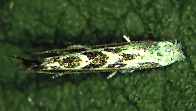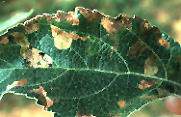
Lyonetia Leafminer, Lyonetia speculella Clemens
I. Introduction: Although first reported
from
apple in the 1920's, this is a relatively new
leafminer pest on apple in the mid-Atlantic region, first noticed
as a
common leafminer in the early 1980's
in Virginia and West Virginia. Mining activity is restricted to
young
leaves; it is therefore more common
on young, non-bearing trees since all leaves are succulent and
vigorous.
II. Hosts: Apple, plum, cherry, birch and grape.
III. Description: Adults are about the same size as the
moths of
spotted tentiform leafminer,
but are predominantly silver-gray in color with white bands on the
wings (Plate 54). There is a tuft
of upward-projecting scales on the top of the head. Larvae are
pale
green in color, and may be seen
descending on a strand of silk to a new leaf.

IV. Biology: The life history of this species is poorly
known
and is the subject of research
in our region. Adults overwinter. Eggs are laid in the undersides
of
expanding leaves. Mines begin as
narrow, winding, serpentine paths that turn into broad, irregular
brown
blotches. Clumps of black frass
may be seen hanging from holes in the mines. Larvae may leave the
mine
and start a new mine, sometimes
on a different leaf. This is important since more than 60 mines
may be
initiated on a single leaf; successful
development of this many larvae in one leaf is unlikely. Larvae
leave
the leaf for pupation, which occurs in
a silken "hammock" spun by the larva on the underside of the leaf
(Plate 55). There are probably 4-6
generations per season, the first occurring in April. The first
generation is usually in very low
densities. By midsummer, there is considerable overlap of
generations
and all growth stages may be found
at any time.
V. Injury: Mines are the most visible evidence of this
species
(Plate 56). Several mines may overlap
on a leaf, turning the whole leaf brown. Most injury is done from
mid-late summer, and may be a problem in
non-bearing trees, where a great proportion of leaves are
susceptible
to attack.

VI. Monitoring: Watch for the presence of young mines on
young
leaves, mainly on nonbearing trees. No
thresholds are currently available.
This is taken primarily from a chapter by
D.G.
Pfeiffer, L.A. Hull, D.J. Biddinger, & J.C. Killian on apple
indirect pests, reprinted with permission from Mid-Atlantic
Orchard
Monitoring Guide, published by NRAES, 152 Riley-Robb Hall,
Ithaca,
New York 14853-5701.
Back to Virginia
Apple
Page
Back to Home Page for "Arthropod Management
in
Fruit Crops" course
Back to Virginia Fruit
Page